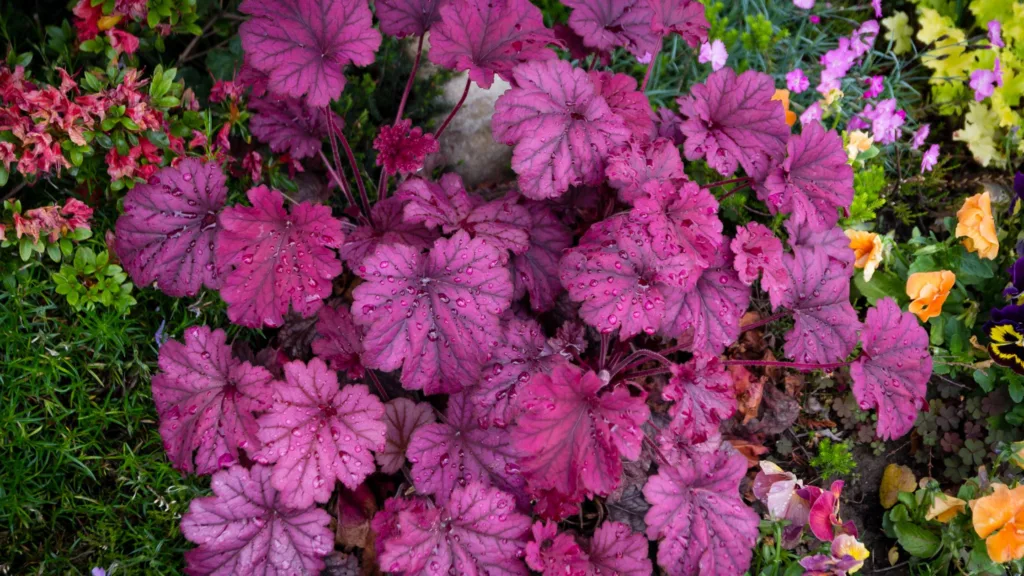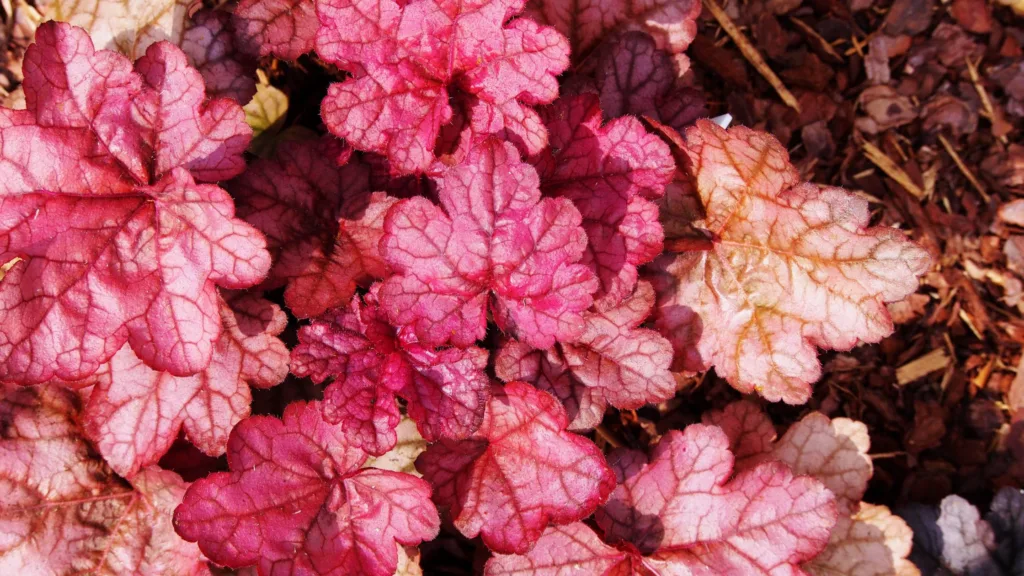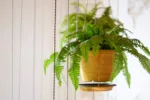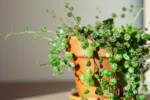Heuchera plant, also known as coral bells, is a popular shade-loving perennial known for its colorful foliage. There are hundreds of varieties available, each with unique leaf shapes, sizes, and colors. Here are some of the most popular varieties:
Heuchera varieties
- Heuchera ‘Obsidian’: This variety has dramatic dark purple foliage that holds its color well throughout the season.
- Heuchera ‘Lime Marmalade’: This variety has bright green, ruffled leaves that will add a splash of color to any shade garden.
- Heuchera ‘Can-Can’: This variety has dramatically marbled leaves in shades of green, cream, and pink.
- Heuchera ‘Citronelle’: This variety has acid-green leaves that are a great choice for a bright shade garden.
- Heuchera ‘Delta Dawn’: This variety has light green leaves with a silvery overlay. It’s a great choice for a shady border.
- Heuchera ‘Ebony and Ivory’: This classic variety features dark purple leaves with contrasting white flowers.
- Heuchera ‘Green Spice’: This variety has bright green leaves with red veins. It’s a great choice for adding a touch of color to a shady border.
- Heuchera ‘Amber Waves’: This variety has fiery orange foliage that emerges in the spring and deepens to a beautiful red in the fall.
- Heuchera ‘Midnight Rose’: This variety has dramatic pink-flecked deep purple leaves.

Heuchera flowers
Heuchera, commonly known as Coral Bells, is a colorful perennial plant that adds a pop of color and texture to gardens. Here are some key points about Heuchera:
- Foliage Focus:
- The primary appeal of coral bells lies in their attractive foliage. Most varieties have deep purple or burgundy leaves, but you can find colors ranging from red to lime green.
- While Heuchera does produce small bunches of bell-shaped flowers, these flowers are delicate and not very flashy. The foliage steals the show!
- Light Requirements:
- Heuchera is considered a shade plant, thriving with about 4-6 hours of sunlight per day.
- However, it’s versatile and can tolerate lighting conditions, including full sun.
- Hardiness Zones:
- Most Heuchera varieties grow well in USDA Hardiness Zones 4-9, with the sweet spot being zones 5-7.
- Some species can even handle colder climates (zone 3) or warmer regions (zone 11).
- Container Gardening:
- Coral bells are great for containers. They mingle well with other plants and come in a variety of colors, making them an easy complement to any design.

Heuchera flowering time
Heuchera, also known as Coral Bells, produces delicate bloom stalks that resemble spikes of small red, white, or pink bell-like flowers. These charming blooms typically appear from late spring to early summer. Enjoy their colorful display in your garden
Heuchera plant problems
Here are some of the most common Heuchera problems and how to address them:
Incorrect Lighting:
- Problem: Heucheras prefer dappled shade or morning sun with afternoon shade. Too much sun can scorch the leaves.
- Solution: Move your Heuchera to a shadier location or provide shade with taller plants.
Watering Issues:
- Problem: Both underwatering and overwatering can be detrimental. Underwatered Heuchera will wilt, while overwatered Heuchera can develop root rot.
- Solution: Water deeply when the top inch of soil feels dry. Avoid constantly wet soil.
Pests and Diseases:
- Pests: Black vine weevils are the most common pest. They chew notches on the leaves.
- Diseases: Fungal diseases like rust and downy mildew can cause leaf spots and discoloration.
- Solution: For pests, hand them off or use insecticidal soap. For diseases, improve air circulation and remove infected leaves. In severe cases, fungicide might be necessary.
Crown Rot:
- Problem: This fungal disease occurs when the plant’s crown is constantly wet.
- Solution: Improve drainage by amending the soil with compost or moving the plant to a raised bed. Avoid overwatering.
Other Problems:
- Heaving: In cold climates, frost heaving can push Heuchera out of the ground.
- Leggy growth: Over time, the crown of the Heuchera might rise above the soil surface.
Solutions:
- Heaving: Mulch around the base of the plant in fall for winter protection.
- Leggy growth: You can bury the exposed stem or divide the plant to encourage new growth.
Heuchera evergreen
While Heuchera is often considered semi-evergreen, some varieties hold their foliage throughout winter in milder climates. Here’s what you need to know:
- Technically Semi-Evergreen: Most Heuchera varieties will lose some older leaves in colder climates, especially during harsh winters. However, they’ll retain a good portion of their foliage, especially the newer growth near the crown.
- Evergreen Varieties: In zones 6 and above (where winter temperatures typically stay above -10°F), some Heuchera varieties can be truly evergreen, keeping their leaves all year round. Here are a few popular evergreen options:
- Heuchera ‘Obsidian’: This classic variety with dramatic dark purple foliage is known for its excellent winter resilience.
- Heuchera ‘Green Spice’: This bright green variety with red veins holds its color well and provides winter interest.
- Heuchera ‘Black Bird’: This dark-leaved beauty boasts near-black foliage that persists through winter.
- Heuchera villosa varieties: Many Heuchera villosa varieties, like ‘Palace Purple,’ are known for their exceptional winter hardiness and evergreen foliage.
- Factors Affecting Evergreen Behavior: Even evergreen varieties might experience some leaf loss in colder winters or with insufficient winter protection. Here’s how to help them stay evergreen:
- Planting Zone: Choose Heuchera varieties suited for your climate zone.
- Winter Mulch: Apply a layer of mulch around the base of the plant in the fall to insulate the roots.
- Watering: Water occasionally during dry winter spells, especially in exposed locations.



Wow, superb blog layout! How long have you been blogging for? you made blogging look easy. The overall look of your site is great, as well as the content!
great points altogether, you just gained a brand new reader. What would you suggest in regards to your post that you made a few days ago? Any positive?